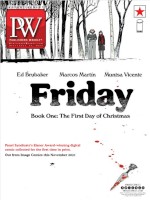In Lloyd’s The Bloodless Boy (Melville House, Nov.), scientist Robert Hooke, England’s Leonardo, investigates gruesome murders in 17th-century London.
What gripped you about Hooke?
When doing my MA degree in the History of Ideas, I stumbled on Hooke’s diary. He was the most extraordinary man, who was the first to observe microorganisms and coined the term cell. He discovered oxygen, although he didn’t name it. He believed fossils were evidence of ancient animals, against the accepted interpretation of the Scriptures.
What was the hardest part of fictionalizing him?
How does somebody of average intelligence portray a genius? That took me some working out. The popular image of Hooke is of a difficult man: argumentative, reclusive, overly jealous of his
reputation. In later life, to be fair, it’s probably an accurate description. But in the period of this book, Hooke’s diary shows him to be at the height of his powers, social, collaborative, and phenomenally busy. A single day might detail meeting dozens of people. He also inspired great loyalty among his friends. So this mixture became my mental image of him:
perhaps some elements of crankiness, but far more interested in the physical world than in himself.
What did you learn about the period that most surprised you?
Seventeenth-century justice constantly shocks. One crime that’s worth mentioning, as it touches on the plot, was “spiriting.” Children were stolen and taken to the Colonies by “spirits.” This was a lucrative business, benefiting those who invested in and ran the Colonies. Although the crime of spiriting was made punishable by death in 1670, actually this was rarely applied, small fines being imposed instead. Spiriting was part of the plantation enterprise. It was people trafficking on a grand scale.
What were murder investigations like at the time?
Medical jurisprudence emerged in the 1600s, courts asking physicians and surgeons for their opinions in legal proceedings. The autopsy of a certain murder victim in London in 1678 shows how detailed investigation into a suspected murder could be, listing the various marks on the body and seeking reasons for them—and sparking debate on the true manner of his death lasting until today. It’s a mistake, I think, to assume such investigations would have been cursory or crude. Hooke was an expert in microscopy. Reading his description of the differences between linen and lawn cloth triggered my idea that he could use his knowledge to solve a murder.



 Volume 268
Issue 37
09/13/2021
Volume 268
Issue 37
09/13/2021





